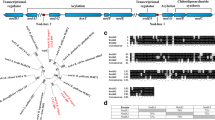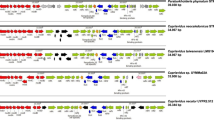Abstract
Mesorhizobium ciceri is a host specific bacterium which nodulates the genus, Cicer. Host specificity is regulated at first step by induction of nodulation (nod) genes in the presence of NodD protein and inducers (flavonoids) of plant origin. The inducer specificity of M. ciceri nodD gene was studied in NodD-mutant strain HN-9 carrying heterologous nodD genes and nodAlacZ fusion. The induction profile of nod promoter in M. ciceri revealed that nodD gene product of M. ciceri is specifically activated by chickpea root exudates only. M. ciceri HN-9 (nodA-lacZ) containing heterologous nodD genes from Rhizobium leguminosarum bv. viciae, R. leguminosarum bv. trifolii and Sinorhizobium meliloti was induced in presence of a number of flavonoids. On the other hand, induction profile of nod promoter showed that heterologous nodD gene products were activated to different levels in NodD− mutant of M. ciceri in presence of root exudates from homologous as well as heterologous legume hosts. The transfer of FITA (Flavonoid independent transcription activation) nodD gene in NodD− mutant, M. ciceri HN-9, was able to break the inducer specificity barrier and nod promoter was induced to maximum level irrespective of the presence or absence of inducer. It is concluded from the results that host specificity in M. ciceri — chickpea (Cicer arietinum) symbiosis is regulated at first step by the host specific interaction of nodD gene product of M. ciceri and inducers present in the root exudates of chickpea.
Similar content being viewed by others
References
Barnett MJ and Long SR (1990). DNA sequence and translational product of a new nodulation-regulatory locus: SyrM has sequence similarity to NodD proteins. J. Bacteriol. 172: 3695–3700
Bassam BJ, Djordjevic MA, Redmond JW, Batley M and Rolfe BG (1988). Identification of a nodD — dependent locus in the Rhizobium strain NGR234 activated by phenolic factors secreted by soybeans and other legumes. Mol. Plant-Microbe Interact. 1: 161–168
Burn JE, Hamilton WD, Wootton JC and Johnston AWB (1989). Single and multiple mutations affecting properties of the regulatory gene nodD of Rhizobium. Mol. Microbiol. 3: 1567–1577
Cardenas L, Dominguez J, Quinto C, Lopez-Lara IM, Lugtenberg BJJ, Spaink HP, Rademaker GJ, Haverkamp J and Thomas-Oates JE (1995). Isolation, chemical structures and biological activity of the lipochitin oligosaccharide nodulation signals from Rhizobium etli. Plant Mol. Biol. 29: 453–464
Davis EO and Johnston AWB (1990). Regulatory functions of the three nodD genes of Rhizobium leguminosarum bv. phaseoli. Mol. Microbiol. 4: 933–941
Denarie J, Debelle F and Prome JC (1996). Rhizobium lipochitooligosaccharide nodulation factors: signaling molecules mediating recognition and morphogenesis. Ann. Rev. Biochem. 65: 503–535
Dixon RA and Palva NL (1995). Stress-induced phenylpropanoid metabolism. Plant Cell 7: 1085–1097
D’Haeze W and Holsters M (2002). Nod factor structures, responses, and perception during initiation of nodule development. Glycobiology 12: 79–105
Djordjevic MA, Redmond JW, Batley, M and Rolfe BG (1987). Clovers secrete specific phenolic compounds which either stimulate or repress nod gene expression in Rhizobium trifolii. EMBO J. 6: 1173–1179
Djordjevic MA, Schofield PR, Ridge RW, Morrison MA, Bassam BJ, Watson JM and Rolfe BG (1985a). Rhizobium nodulation genes involved in host root hair curling are functionally conserved. Plant Mol. Biol. 4: 147–160
Djordjevic MA, Schofield PR and Rolfe BG (1985b). Tn5 mutagenesis of Rhizobium trifolii host-specific nodulation genes result in mutants with altered host range ability. Mol. Gen. Genet. 200: 463–471
Downie JA, Knight CD, Johnston AWB and Rossen L (1985). Identification of genes and gene products involved in the nodulation of peas by Rhizobium leguminosarum. Mol. Gen. Genet. 198: 255–262
Feng J, Li Q, Hu HL, Chen XC and Hong GF (2003). Inactivation of the nod box distal half-site allows tetrameric NodD to activate nodA transcription in an inducer-independent manner. Nucleic Acids Res. 31: 3143–3156
Fisher RF and Long SR (1993). Interactions of NodD at the nod box: NodD binds to two distinct sites on the same face of the helix and induces a bend in the DNA. J. Mol. Biol. 233: 336–348
Geurts R and Bisseling T (2002). Rhizobium Nod factor perception and signalling. Plant Cell 14(suppl.): S239–S249
Gyorgypal Z, Kondorosi E and Kondorosi A (1991). Diverse signal sensitivity of NodD protein homologs from narrow and broad host range rhizobia. Mol. Plant-Microbe Interact. 4: 356–364
Hartwig UA, Maxwell CA, Joseph CM and Phillips DA (1989). Interactions among flavonoid nod gene inducers released from alfalfa seeds and roots. Plant Physiol. 91: 1138–1142
Honma MA and Ausubel FM (1987). Rhizobium meliloti has three functional copies of the nodD symbiotic regulatory gene. Proc. Natl. Acad. Sci.USA 84: 8558–8562
Horvath B, Bachem CW, Schell J and Kondorosi A (1987). Host specific regulation of nodulation genes in Rhizobium is mediated by a plant signal interacting with the nodD gene product. EMBO J. 6: 841–848
Kamboj DV, Upadhyay KK and Sharma PK (2003). Isolation and characterization of NodD− mutants of Rhizobium ciceri. Physiol. Mol. Biol. Plants 9: 1–11
Kape R, Parniske M, Brandt S and Werner D (1992). Isoliquiritigenin, a strong nod gene- and glyceollin resistance-inducing flavonoid from soybean root exudate. Appl. Environ. Microbiol. 58: 1705–1710
Kobayashi H, Naciri-Graven Y, Broughton WJ and Perret X (2004). Flavonoids induce temporal shifts in geneexpression of nod-box controlled loci in Rhizobium sp. NGR234. Mol. Microbiol. 51(2): 335–347
Kobayashi H and Broughton WJ (2008). Fine-tuning of symbiotic genes in rhizobia: flavonoid signal transduction cascade. In: Nitrogen-fixing leguminous symbioses. (Eds. Dilworth, MJ, James, EK, Sprent, JI and Newton, WE), Springer, Netherlands, pp. 117–152
Kosslak RM, Bookland R, Barkei J, Paaren HE and Appelbaum ER (1987). Induction of Bradyrhizobium japonicum common nod genes by isoflavones isolated from Glycine max. Proc. Natl. Acad. Sci. USA 84: 7428–7432
Le Strange KK, Bender GL, Djordjevic MA, Rolfe BG and Redmond JW (1990). The Rhizobium strain NGR234 nodD1 gene product responds to activation by simple phenolic compounds vanillin and isovanillin present in wheat seedling extracts. Mol. Plant-Microbe Interact. 3: 214–220
Lindstrom, K, Paulin, L, Roos, C and Suominen, L (1995). Nodulation genes of Rhizobium galegae. In: Nitrogen Fixation: Fundamentals and Applications. (Eds. Tikhonovich, I.A., Provorov, N.A., Romanov, V.I. and Newton, W.E.), Kluwer Academic Publishers, Dordrecht, pp. 365–370
Long SR (1996). Rhizobium symbiosis: Nod factors in perspective. Plant Cell 8: 1885–1898
Machado D and Krishnan HB (2003). The nodD alleles of Sinorhizobium fredii USDA191 differentially influence soybean nodulation, nodC expression and production of exopolysaccharides. Curr. Microbiol. 47(2): 134–137
Miller JH (1972). Experiments in molecular genetics. Cold Spring Harbor, New York
Peters NK, Frost JW and Long SR (1986). A plant flavone, luteolin, induces expression of Rhizobium meliloti nodulation genes. Science 233: 977–980
Peters NK and Long SR (1988). Alfalfa root exudates and compounds which promote or inhibit induction of Rhizobium meliloti nodulation genes. Plant Physiol. 88: 396–400
Phillips DA, Dakora FD, Sande E, Joseph CM and Zon J (1994). Synthesis, release and transmission of alfalfa signals to rhizobial symbionts. Plant Soil 161: 69–80
Recourt K, Schripsema J, Kijne JW, van Brussel AAN and Lugtenberg BJJ (1991). Inoculation of Vicia sativa subsp. nigra roots with Rhizobium leguminosarum biovar viciae results in release of nod gene activating flavonones and chalcones. Plant Mol. Biol. 16: 841–852
Redmond JW, Batley M, Djordjevic MA, Innes RW, Kuempel PL and Rolfe BG (1986). Flavones induce expression of nodulation genes in Rhizobium. Nature 323: 632–634
Rossen L, Shearman CA, Johnston AWB and Downie JA (1985). The nodD gene of Rhizobium leguminosarum is autoregulatory and in the presence of plant exudates induces the nodA, B, C genes. EMBO J. 4: 3369–3373
Schlaman HRM, Okker RJH and Lugtenberg BJJ (1992). Regulation of nodulation gene expression by NodD in rhizobia. J. Bacteriol. 174: 5177–5182
Sharma PK, Anand RC and Lakshminarayana K (1991). Construction of Tn5 tagged mutants of Rhizobium sp. (Cicer) for ecological studies. Soil Biol. Biochem. 23: 881–885
Sharma PK, Kundu BS and Dogra RC (1993). Molecular mechanism of host specificity in legume- Rhizobium symbiosis. Biotech. Adv. 11: 741–779
Sharma PK, Upadhyay KK and Srivastva P (1994). Nodulation and nitrogen fixation ability of wild species of Cicer. Legume Res. 17: 229–230
Spaink HP, Okker RJH, Wijffelman CA, Pees E and Lugtenberg BJJ (1987a). Promoters in the nodulation region of the Rhizobium leguminosarum Sym plasmid pRL1JI. Plant Mol. Biol. 9: 27–39
Spaink HP, Okker RJH, Wijffelman CA, Tak T, Goosen-De Roo L, Pees E, van Brussel AAN and Lugtenberg BJJ (1989a). Symbiotic properties of rhizobia containing a flavonoid-independent hybrid nodD product. J. Bacteriol. 171: 4045–4053
Spaink HP, Wijffelman CA, Pees E, Okker RJH and Lugtenberg BJJ (1987b). Rhizobium nodulation gene nodD as a determinant of host specificity. Nature 328: 337–340
Spaink HP, Wijffelman CA, Pees E, Okker RJH and Lugtenberg BJJ (1989b). Localization and functional regions of the Rhizobium nodD product using hybrid nodD genes. Plant Mol. Biol. 12: 59–73
Srivastava P, Sharma PK and Dogra RC (1999). Inducers of nod genes of Rhizobium ciceri. Microbiol. Res. 154: 49–55
Suominen L, Luukkainen R, Roos C and Lindstrom K (2003). Activation of the nodA promoter by the nodD genes of Rhizobium galegae induced by synthetic flavonoids or Galega orientalis root exudate. FEMS Microbiol. Lett. 219: 225–232
Tak T, van Spronsen PC, Kijne JW, van Brussel AA and Boot KJ (2004). Accumulation of lipochitin oligosaccharides and NodD-activating compounds in an efficient plant-Rhizobium nodulation assay. Mol. Plant Microbe Interact. 17: 816–823
van Rhijn P and Vanderleyden J (1995). The Rhizobium-plant symbiosis. Microbiol. Rev. 59: 124–142
van Rhijn P, Feys B, Verreth C and Vanderleyden J (1993). Multiple copies of nodD in Rhizobium tropici CIAT899 and BR816. J. Bacteriol. 175: 438–447
Vincent JM (1970). A manual for the practical study of the root nodule bacteria. I.B.P. Handbook no. 15. Blackwell Scientific Publications, Oxford
Wijffelman CA, Pees E, van Brussel AAN, Okker RJH and Lugtenberg BJJ (1985). Genetic and functional analysis of the nodulation region of the Rhizobium leguminosarum sym plasmid pRL1JI. Arch. Microbiol. 143: 225–232
Zaat SAJ, Schripsema J, Wijffelman CA, van Brussel AAN and Lugtenberg BJJ (1989). Analysis of the major inducers of the Rhizobium nodA promoter from Vicia sativa root exudate and their activity with different nodD genes. Plant Mol. Biol. 13: 175–188
Zaat SAJ, Wijffelman CA, Spaink HP, van Brussel AAN, Okker RJH and Lugtenberg BJJ (1987). Induction of nodA promoter of R. leguminosarum sym plasmid pRL1JI by plant flavones and flavonones. J. Bacteriol. 169: 198–204
Author information
Authors and Affiliations
Corresponding author
Rights and permissions
About this article
Cite this article
Kamboj, D.V., Bhatia, R., Pathak, D.V. et al. Role of nodD gene product and flavonoid interactions in induction of nodulation genes in Mesorhizobium ciceri . Physiol Mol Biol Plants 16, 69–77 (2010). https://doi.org/10.1007/s12298-010-0009-7
Published:
Issue Date:
DOI: https://doi.org/10.1007/s12298-010-0009-7




